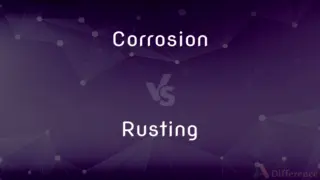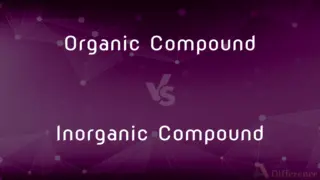Reticulocyte vs. Erythrocyte — What's the Difference?
Edited by Tayyaba Rehman — By Fiza Rafique — Updated on March 25, 2024
A reticulocyte is an immature red blood cell (RBC) without a nucleus, indicating recent production in the bone marrow, while an erythrocyte is a mature RBC, fully developed to carry oxygen throughout the body.

Difference Between Reticulocyte and Erythrocyte
Table of Contents
ADVERTISEMENT
Key Differences
Reticulocytes are the precursors to erythrocytes, representing an intermediate stage in red blood cell development. They are produced in the bone marrow and released into the bloodstream, where they mature into erythrocytes within 1 to 2 days. Reticulocytes still contain some cellular organelles and RNA, which are absent in erythrocytes. This remaining RNA is what gives reticulocytes their name, as it can be stained to form a reticular (net-like) pattern under a microscope. On the other hand, erythrocytes are the most common type of blood cell and the body's principal means of delivering oxygen to the body tissues via blood flow through the circulatory system. Erythrocytes are characterized by their distinctive biconcave shape, lack of a nucleus, and the presence of hemoglobin, which binds oxygen.
The primary function of reticulocytes is to develop into fully functional erythrocytes. The presence of reticulocytes in the blood is an indicator of bone marrow activity and erythropoiesis (the production of red blood cells). A high reticulocyte count can indicate increased red blood cell production, often in response to anemia or blood loss. Whereas, erythrocytes are responsible for the transport of oxygen from the lungs to the rest of the body and the return transport of carbon dioxide to the lungs for exhalation.
Reticulocyte counts are crucial in diagnosing and managing various hematological and medical conditions. A higher-than-normal count can suggest conditions such as hemolytic anemia or acute blood loss, where the body is producing more red blood cells to compensate for the loss or destruction of existing cells. Conversely, erythrocytes' efficiency in oxygen transport is critical for metabolic processes, and abnormalities in their count or function can lead to conditions like anemia (low count) or polycythemia (high count).
The lifespan of a reticulocyte in the bloodstream is short, typically around 1 to 2 days before it matures into an erythrocyte. Erythrocytes have a lifespan of approximately 120 days, after which they are removed from circulation by the spleen. The mature erythrocytes' lack of a nucleus and other organelles is an adaptation that allows more room for hemoglobin, enhancing their oxygen-carrying capacity.
While reticulocytes and erythrocytes are closely related in the red blood cell development process, their roles, structural characteristics, and clinical significance differ markedly, reflecting their stages in the erythropoietic cycle and their functions in the body's circulatory and respiratory systems.
ADVERTISEMENT
Comparison Chart
Definition
Immature red blood cell, a precursor to an erythrocyte.
Mature red blood cell, fully developed to carry oxygen.
Presence of RNA
Contains residual RNA.
Does not contain RNA.
Function
Maturation into erythrocytes.
Transportation of oxygen and carbon dioxide.
Lifespan in Blood
1 to 2 days before maturing into an erythrocyte.
Approximately 120 days.
Clinical Significance
Indicator of bone marrow activity and red blood cell production.
Reflects the body's capacity to transport oxygen and carbon dioxide.
Compare with Definitions
Reticulocyte
Transient stage in red blood cell development.
Reticulocytes mature into erythrocytes within 1-2 days after entering the bloodstream.
Erythrocyte
Essential for transporting carbon dioxide back to the lungs.
Erythrocytes play a key role in carbon dioxide removal from tissues.
Reticulocyte
Indicator of erythropoiesis rate.
Low reticulocyte counts may indicate inadequate bone marrow response.
Erythrocyte
A mature red blood cell that carries oxygen.
Erythrocytes transport oxygen from the lungs to tissues.
Reticulocyte
A young red blood cell with residual RNA, indicating recent production.
High reticulocyte counts suggest active red blood cell regeneration.
Erythrocyte
Lacks a nucleus and organelles to maximize hemoglobin content.
The biconcave shape of erythrocytes increases the surface area for oxygen exchange.
Reticulocyte
Measured to assess bone marrow function.
Reticulocyte percentages are elevated in response to anemia treatment.
Erythrocyte
The most abundant cell type in human blood.
The average adult has about 5 million erythrocytes per microliter of blood.
Reticulocyte
Visible under a microscope with special stains.
Reticulocytes display a reticular pattern when stained with supravital dyes.
Erythrocyte
Lifespan of about 120 days in the bloodstream.
Old erythrocytes are removed by the spleen.
Reticulocyte
Reticulocytes are immature red blood cells (RBCs). In the process of erythropoiesis (red blood cell formation), reticulocytes develop and mature in the bone marrow and then circulate for about a day in the blood stream before developing into mature red blood cells.
Erythrocyte
See red blood cell.
Reticulocyte
An immature red blood cell that (in mammals) lacks a nucleus but contains a network of filaments consisting of residual RNA and organelles. Reticulocytes move from the bone marrow into the bloodstream.
Erythrocyte
A hemoglobin-containing cell, especially as found in humans but more generally present in the blood of most vertebrates, that is involved with the transport of oxygen; such cells are usually anucleate in humans and many other animals.
Reticulocyte
An immature red blood cell, having a reticular network of RNA
Erythrocyte
A mature blood cell that contains hemoglobin to carry oxygen to the bodily tissues; a biconcave disc that has no nucleus
Reticulocyte
An immature red blood cell containing a network of filaments or granules
Common Curiosities
What distinguishes a reticulocyte from an erythrocyte?
Reticulocytes are immature red blood cells with some residual RNA, while erythrocytes are mature, fully developed red blood cells without RNA.
Why are reticulocyte counts important?
They provide insight into bone marrow activity and the body's capacity to produce red blood cells, useful in diagnosing and monitoring conditions like anemia.
How does the structure of an erythrocyte facilitate its function?
Its biconcave shape and lack of nucleus increase surface area and interior space for hemoglobin, enhancing oxygen transport efficiency.
What happens to erythrocytes after their lifespan ends?
They are removed from circulation and broken down in the spleen, with their components recycled for new cell production.
What is the significance of erythrocytes in blood tests?
Erythrocyte counts, size, and hemoglobin content are key indicators of the blood’s oxygen-carrying capacity and overall health.
Can reticulocyte and erythrocyte counts indicate health conditions?
Yes, deviations from normal counts can indicate various health issues, including anemia, blood loss, or bone marrow disorders.
How quickly do reticulocytes turn into erythrocytes?
Reticulocytes typically mature into erythrocytes within 1 to 2 days after being released into the bloodstream.
What role does the bone marrow play in erythrocyte production?
It is the primary site of erythropoiesis, where erythrocytes are produced from hematopoietic stem cells.
Why might a person have a high reticulocyte count?
High counts can result from conditions requiring increased red blood cell production, such as recovery from anemia or significant blood loss.
What factors can lead to a decrease in erythrocyte production?
Factors include nutritional deficiencies (like iron, vitamin B12, or folate), chronic diseases, bone marrow disorders, and certain medications that affect bone marrow function.
How do reticulocytes mature into erythrocytes?
They lose their residual organelles and RNA, assuming the characteristic biconcave shape and full functionality for oxygen transport.
How does the body regulate the production of erythrocytes?
The production is primarily regulated by the hormone erythropoietin, produced by the kidneys in response to low oxygen levels in the blood.
Can the number of reticulocytes in the blood affect oxygen transport?
Since reticulocytes are less efficient at oxygen transport than mature erythrocytes, a high proportion can indicate a compromised oxygen transport capacity, often seen in regenerative anemias.
What is the clinical significance of measuring both reticulocyte and erythrocyte counts together?
Measuring both provides a comprehensive view of the body’s blood production and oxygen-carrying capacity, helping diagnose and monitor conditions like anemia, bone marrow function, and the effectiveness of treatments involving red blood cell production.
Share Your Discovery

Previous Comparison
Corrosion vs. Rusting
Next Comparison
Software vs. HardwareAuthor Spotlight
Written by
Fiza RafiqueFiza Rafique is a skilled content writer at AskDifference.com, where she meticulously refines and enhances written pieces. Drawing from her vast editorial expertise, Fiza ensures clarity, accuracy, and precision in every article. Passionate about language, she continually seeks to elevate the quality of content for readers worldwide.
Edited by
Tayyaba RehmanTayyaba Rehman is a distinguished writer, currently serving as a primary contributor to askdifference.com. As a researcher in semantics and etymology, Tayyaba's passion for the complexity of languages and their distinctions has found a perfect home on the platform. Tayyaba delves into the intricacies of language, distinguishing between commonly confused words and phrases, thereby providing clarity for readers worldwide.















































